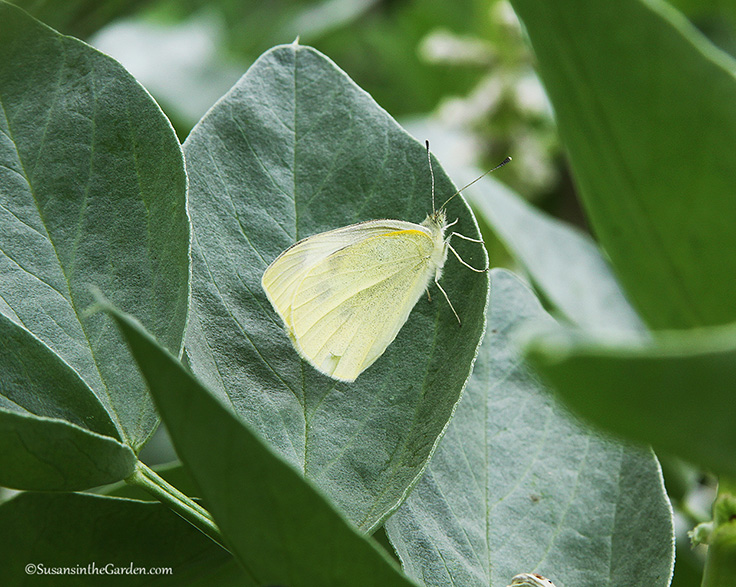Column: Cabbage Worms

While today’s garden column might sound icky, I’m hoping you’ll find it interesting and helpful.
As most folks know, cabbage family crops (also known as Brassicas) are quite prone to insect problems. The primary culprits are aphids and cabbage worms. I’ve written about aphids but thought you’d like to know more about the latter because a little bit of knowledge goes a long way!
In my column, I explain there are actually three types of “cabbage worms.” The cabbage white butterfly is pictured at left and is active during the day. The other two types (cabbage loopers and diamondback caterpillars) are actually the offspring of moths, which are nocturnal.
Here’s my column:
by Susan Mulvihill
It is a treat to harvest and eat your very own homegrown broccoli and cabbage. But it’s not so delightful if your harvest is accompanied by a bunch of green caterpillars on the leaves.
There are three species of Brassica-munching caterpillars that Inland Northwest gardeners might encounter. Cabbage worms are the larval stage of imported cabbage white butterflies (Pieris rapae). Cabbage loopers are the offspring of the cabbage looper moth (Trichoplusia ni), and diamondback caterpillars are the larval stage of diamondback moths (Plutella xylostella).
The adult female of each species lays eggs on plant leaves. After hatching, the larvae go through different stages of their life cycle while feeding on the host plant’s leaves. They eventually create a cocoon to pupate in, then emerge as the adult form. The females mate and lay eggs, which starts the cycle all over again.
Each species’ caterpillars are green and their feeding activities leave jagged holes in the leaves. You’ll often see them on the undersides of a leaf, near the midrib. As you might guess, they are attracted to cabbage family crops which include arugula, bok choy, broccoli, Brussels sprouts, cabbage, cauliflower, collards, kale, kohlrabi, mustard, radishes, rutabagas and turnips. I’ve read that cabbage looper caterpillars also feed on lettuce, peas, potatoes and spinach but have never encountered them on those crops in my garden.
There are a few ways to deal with these annoying insect pests. My favorite method is to create a barrier that prevents the adults butterflies or moths and their offspring from getting onto the plants. To do this, I place hoops over the bed and suspend either floating row cover or agricultural insect netting on top of them.
Floating row cover is a lightweight fabric that lets sunlight and moisture through it. Insect netting has a tiny mesh that keeps out insects and it’s easy to see through it to check on how plants are doing, rather than having to lift it off. I love creating a barrier because I don’t have to resort to using any sprays, organic or otherwise.
If you don’t want to cover your crop, you still have options. You can squish any eggs or caterpillars that you find or you can spray the plants with Bacillus thuringiensis, also known as Bt. These bacteria are harmless to humans but deadly to the caterpillar stage of insects. This product is easy to find at garden centers. Be sure to spray both sides of the leaves but avoid spraying it on or near flowers.
I recently read about an interesting alternative for repelling cabbage white butterflies. It involves making butterfly decoys and placing them in the beds where you’re growing cabbage family crops. The information indicated that female butterflies won’t deposit eggs where females of the same species are laying eggs.
Do a web search for female cabbage white butterfly clip-art, copy a page’s worth of them to a blank document and print it out. Cover the butterflies on each side with clear plastic shipping tape, then cut out the shapes. You can also make decoys from the inside surfaces of empty milk cartons. Be sure to put two small black spots at the center of each forewing so it will look like a female (males only have a single black spot). Attach your cutouts to some twine suspended above the plants. I have not tried this yet but think it would be a fun experiment.Susan Mulvihill is author of “The Vegetable Garden Problem Solver Handbook” and “The Vegetable Garden Pest Handbook.” She can be reached at Susan@SusansintheGarden.com. Watch this week’s video at youtube.com/susansinthegarden.

